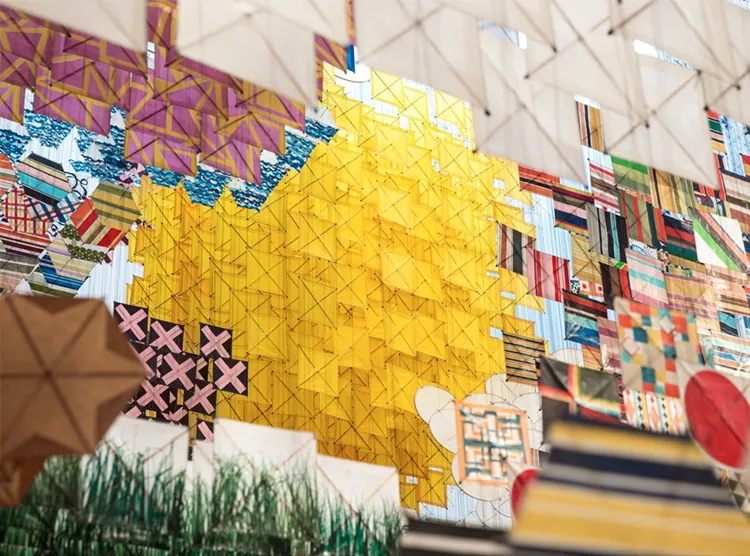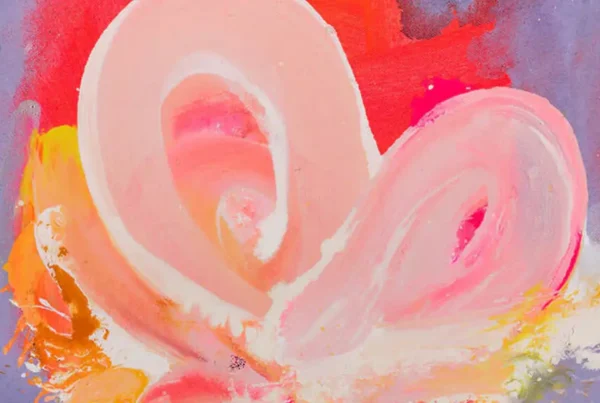Jacob Hashimoto: Weaving Art from Paper, Bamboo, and Pixels
Jacob Hashimoto’s artistry is a unique blend of tradition and innovation, reflecting his intricate journey through different cultures and mediums. Born in Greeley, Colorado, and raised in Walla Walla, Washington, Hashimoto grew up in an environment where art and craftsmanship were ever-present, particularly through his mother’s home studio. His Japanese-American father and Irish-American mother instilled in him a deep appreciation for diverse cultural heritages, but it wasn’t until his time at Carleton College that he fully embraced art as a career. A printmaking class shifted his perspective, leading him to apply to the School of the Art Institute of Chicago, where his artistic identity began to take form.
Although deeply connected to his Japanese roots, Hashimoto’s cultural exploration goes beyond mere representation. His work often features bamboo and paper, materials traditionally used in Japanese kite-making. The subtle beauty and fragility of these elements speak to his fascination with craftsmanship. Despite never having visited Japan, his connection to its traditions runs deep, channeled through his use of Japanese-made paper and bamboo. These materials, while evocative of his heritage, become transformed under his vision, shifting from a historical context into a contemporary and abstract language.
Hashimoto’s process reflects a constant dialogue between the handmade and the conceptual, where delicate materials meet bold artistic expression. His ability to bring together elements from his multicultural background has resulted in work that feels both personal and universal, traditional yet undeniably modern.
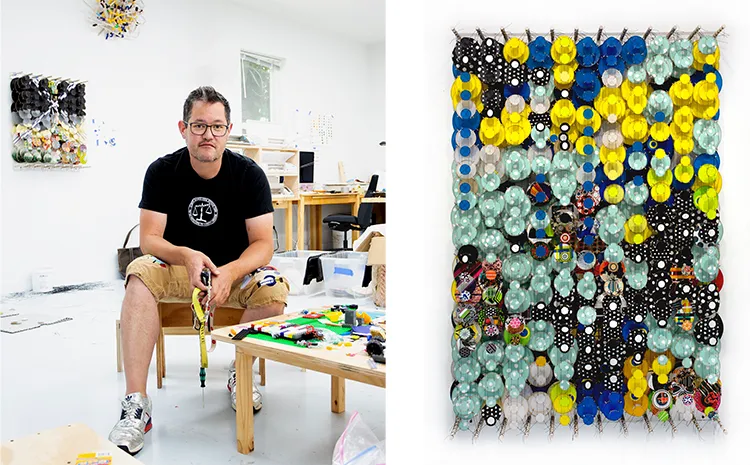
Jacob Hashimoto: Sculpture, Painting, and the Space Between
One of Hashimoto’s most distinctive contributions to contemporary art is his approach to blending sculpture and painting. His installations, often comprised of hundreds or thousands of bamboo-and-paper kites, defy traditional categorizations. He describes his process as “painterly,” not because of the medium he uses, but because of the way he conceives of his compositions. Instead of pigment applied to canvas, Hashimoto arranges individual kites into elaborate configurations, layering them to create works that hover between flatness and depth. Each kite becomes a brushstroke in a larger narrative, where light, shadow, and movement play critical roles.
These installations explore the tension between two-dimensional and three-dimensional spaces, often inviting viewers to engage with them physically. As one walks around or under the floating kites, their perspective shifts, revealing new layers and changing colors. Hashimoto likens this experience to the wind moving through traditional kites, except in his installations, it’s the audience’s movement that animates the work. This interaction allows each piece to evolve continuously, ensuring that no two experiences are the same, thus deepening the viewer’s connection to the art.
By merging these disciplines, Hashimoto not only challenges the conventional boundaries of sculpture and painting but also transforms the space itself into a vital component of the artwork. His installations become immersive environments, drawing viewers into an abstract yet tangible world, where art is experienced, not just seen.
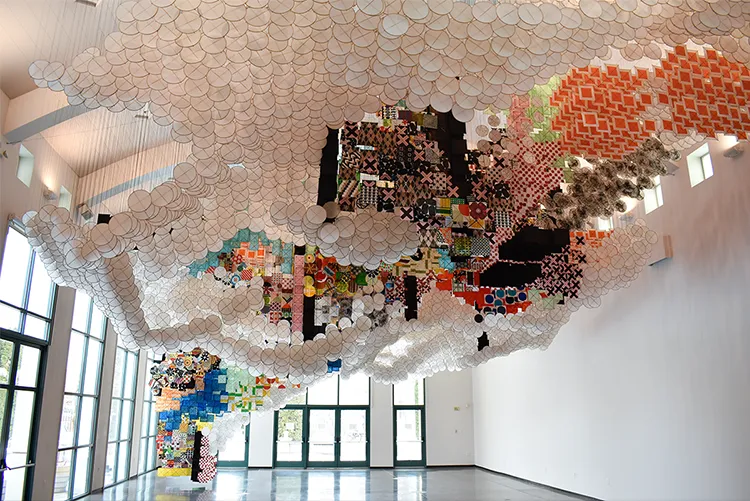
Pixels, Video Games, and the Virtual Influence
A unique aspect of Hashimoto’s work is his incorporation of digital aesthetics, particularly through his fascination with video games and technology. Growing up with a love for video games, Hashimoto sees parallels between the pixelated landscapes of virtual worlds and his kite constructions. Just as pixels build digital worlds, his small, repetitive kite forms create complex, layered landscapes in the physical world. This merging of the digital and the handmade is a recurring theme in his work, one that speaks to the hybrid nature of modern existence, where the physical and virtual realms constantly intersect.
Hashimoto draws inspiration from a wide range of digital influences, from early Atari circuit boards to the more recent world-building elements of Minecraft. These references are not always overt but are embedded in the structure and rhythm of his pieces. His kites, when viewed from a distance, can resemble the pixelated blocks of a video game, an effect that becomes more pronounced as the viewer shifts position. This dialogue between the old-world craftsmanship of kite-making and the modern world of digital technology allows his work to occupy a unique space in contemporary art.
In Hashimoto’s latest exhibitions, this connection between technology and craft is even more pronounced. Works like The Disappointment Engine delve into themes of systems and structures, inspired by everything from natural patterns to digital networks. These pieces reflect his ongoing exploration of how the virtual and physical worlds interact and how art can act as a bridge between the two.
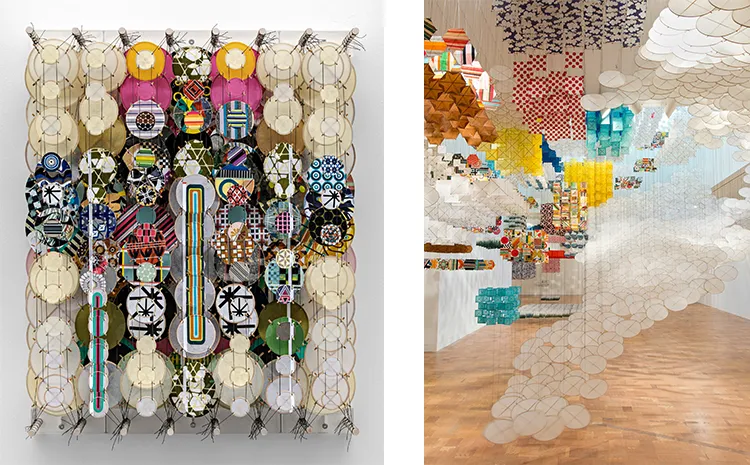
Jacob Hashimoto: Engaging the Viewer in Movement and Meditation
Movement is a fundamental aspect of Hashimoto’s work, not only in the way his pieces are constructed but also in how they are experienced by the viewer. His installations are designed to shift and change depending on the angle and position of the observer. This dynamic quality is intentional, as Hashimoto seeks to create a relationship between the viewer and the work, making the act of walking through and around the installation an essential part of the artistic experience. Much like a kite dancing in the wind, his pieces respond to the presence of the audience, continually revealing new perspectives and details.
At the same time, Hashimoto’s work invites a sense of calm and contemplation. Despite the complexity and scale of his installations, there is a meditative quality to the repetition of forms and the subtle interplay of light and shadow. This balance between chaos and serenity reflects Hashimoto’s own approach to art, where he constantly navigates between control and spontaneity. The kites, though meticulously arranged, possess a sense of fluidity, as if they could shift and flutter at any moment.
The environments in which Hashimoto’s installations are displayed also play a crucial role in shaping how they are perceived. From vast, open spaces like Governors Island in New York to smaller, intimate galleries, each setting offers new challenges and opportunities for engagement. His goal remains the same: to create an immersive experience that transports the viewer into another world, where art becomes a lived, rather than a static, experience. Through movement, light, and material, Hashimoto’s installations encourage viewers to pause, reflect, and lose themselves in the delicate beauty of his intricate creations.
